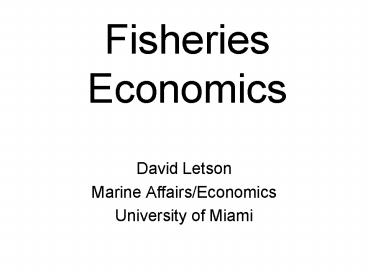Fisheries Economics - PowerPoint PPT Presentation
1 / 18
Title:
Fisheries Economics
Description:
Recreational fishing also important. Flat growth since 1989 understates real decline ... boats, nets, traps; crew; spatial distribution of stocks, fishers, consumers; ... – PowerPoint PPT presentation
Number of Views:1410
Avg rating:3.0/5.0
Title: Fisheries Economics
1
Fisheries Economics
- David Letson
- Marine Affairs/Economics
- University of Miami
2
The Basics
- Fisheries are renewable resources, like forests.
- Unlike forests, we harvest the growth each year.
- Open access and ill-advised public policies.
- We will consider
- efficient management and
- reasons for spectacular counterexamples.
3
Concerns
- Bycatch
- Uncontrolled access
- Technological advances
- Globalization of world markets
- Habitat destruction
- Allocation commercial and recreational
- Transboundary stocks
4
Tragedy of the Commons
- Resource accessible to all but belonging to none
- Individual motivation versus public well being.
- Garrett Hardin
- Resource characteristic or a human institution?
5
Why do they keep fishing?
- Economic motivation
- capture of benefits
- costs of depleted stocks
- subsidies
- Overfishing is rational but inefficient.
- Identity as fishers.
6
Descriptive Statistics
- UN/FAO marine species over-exploited
- US is sixth largest producer
- Recreational fishing also important
- Flat growth since 1989 understates real decline
- Economic losses.
7
ExampleUS Groundfish
- Edwards and Murawski
- Multi-species groundfishery off New England
- 70 reduction in effort would maximize value
- Seven-fold increase in stocks
- Three-fold increase in sustainable yield
- Add value 150M/year.
- Realization depends critically on property rights.
8
What is a fishery?
- Stock of fish
- initial size
- growth rate
- recruitment,
- growth of individuals, and
- mortality.
- Fishing enterprises
- fishing effort
- catch
- costs and revenues
9
Fishing effort
- A composite input to production
- inputs other than the fish stocks.
- Measure of inefficiency.
- Relevant considerations
- boats, nets, traps
- crew
- spatial distribution of stocks, fishers,
consumers - time spent fishing.
10
Biological Assumptions
- Growth of fish stocks is a function of the
initial stock (Schaefer logistical growth). - We focus on recruitment, individual growth, and
natural mortality. - We dont consider salinity, temperature,
currents, weather, predator/prey relationships,
pollution, loss of habitat, etc.
11
Economics of an open-access fishery
- Total sustainable revenue
- Total cost of harvest
- Maximum Sustainable Yield
- Maximum economic yield
12
Extensions
- Fishers not homogeneous.
- Time lags Slow, painful adjustments.
- Multi-species. Multi-nation.
- Individuals sometimes do cooperate.
- Regulators do not always act in social interest.
13
Fisheries Management (I)
- Will future catches compensate for todays
restraint? - Facilitate transfer of resources to beneficial
use? - How will regime affect prices and harvest costs?
- Will improved stocks attract additional effort?
14
Fisheries Management (II)
- Usual approaches
- catch quotas,
- trip limits,
- bag limits,
- gear restrictions,
- limits on fish size, and
- seasonal and area closures.
15
Fisheries Management (III)
- Usual ways Raise harvest costs, with profits
still zero. - Effort increases to take advantage of the
improved stocks and catch rates. - Need use rights for fish stocks.
16
Individual transferable quotas (ITQs)
- Allocates shares of TAC to individuals.
- Fishers still decide who, when and how.
- Design issues
- eligibility, duration, transferability
- Initial allocation.
17
Management Review
- Restrictiveness correlated with success.
- Complexity of fishery, success inversely related.
- Unpopular programs do not succeed.
- Failure necessary before restrictions accepted.
- Success creates pressure to increase access.
18
Conclusions
- World fisheries in decline.
- Open access encourages over-harvest.
- Subsidies worsen problems.
- Management must reduce effort, protect habitat.































